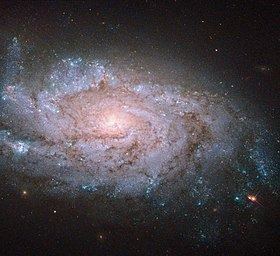Right ascension 02 45 59.9 Redshift 1407 ± 4 km/s Apparent size (V) 3′.2 × 1′.8 | Declination −07° 34′ 42″ Type SA(s)c Magnitude 10.7 Apparent magnitude (V) 10.7 | |
 | ||
Distance 66.8 ± 12.8 Mly (20.51 ± 3.93 Mpc) People also search for NGC 1022, NGC 1087, NGC 1083, NGC 1090, NGC 1088, IC 254 | ||
NGC 1084 is an unbarred spiral galaxy in constellation Eridanus. It is at a distance of about 65 million light-years away from Earth. It was discovered by William Herschel on 10 January 1785. The galaxy has multiple spiral arms, which are not well defined. It belongs in the same group with NGC 988, NGC 991, NGC 1022, NGC 1035, NGC 1042, NGC 1047, NGC 1052 and NGC 1110. The group is associated with Messier 77 group.
NGC 1084 has been home of 5 supernovae in the last 50 years, 1963P (mag. 14), 1996an (type II, mag. 14), 1998dl (type II, mag. 16), 2009H (type II, mag. 17), and 2012ec (type IIP, mag. 14,5). Star formation in the galaxy is chaotic and not confined at the spiral arms of the galaxy, however, not as high as to classify the galaxy as a starburst galaxy. Star formation has taken place in small bursts in the last 40 million years. The reason of this activity has been proposed to be a merger with a gas-rich dwarf galaxy. A radio source has been detacted 3,5' south-west of the galaxy, connected to it by a bridge.
